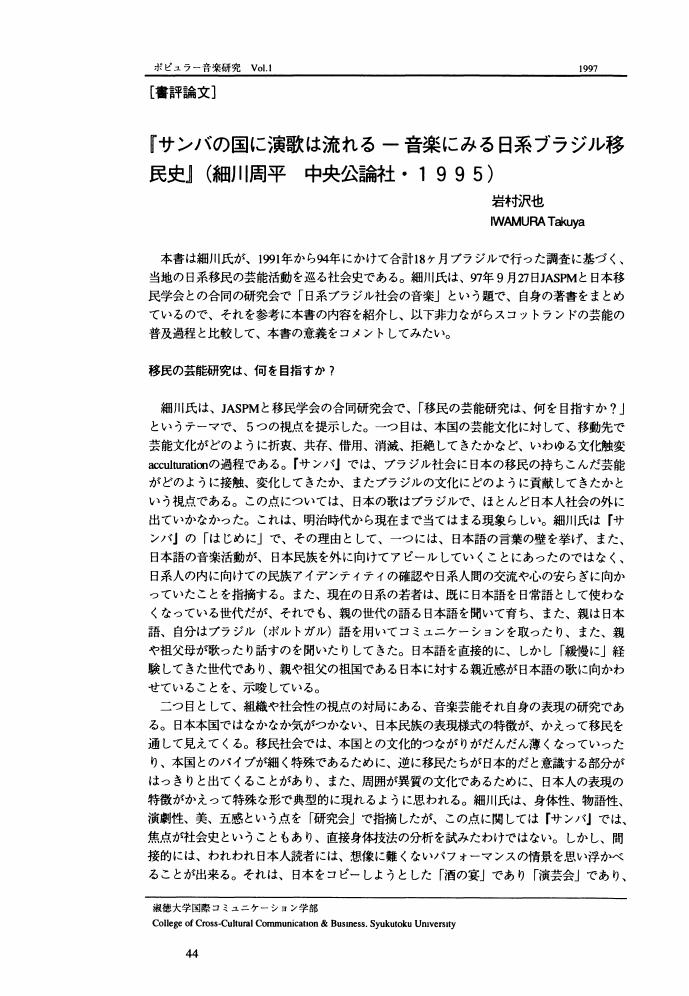- 著者
- 難波 弘之
- 出版者
- 日本ポピュラー音楽学会
- 雑誌
- ポピュラー音楽研究 (ISSN:13439251)
- 巻号頁・発行日
- vol.4, pp.71-82, 2000 (Released:2009-10-29)
10 0 0 0 OA ポピュラー音楽と教育
- 著者
- 小泉 恭子
- 出版者
- 日本ポピュラー音楽学会
- 雑誌
- ポピュラー音楽研究 (ISSN:13439251)
- 巻号頁・発行日
- vol.4, pp.46-57, 2000 (Released:2009-10-29)
- 参考文献数
- 51
9 0 0 0 OA ‘Yesterday Once More’の解釈について
- 著者
- 土屋 唯之
- 出版者
- 日本ポピュラー音楽学会
- 雑誌
- ポピュラー音楽研究 (ISSN:13439251)
- 巻号頁・発行日
- vol.4, pp.20-30, 2000 (Released:2009-10-29)
- 参考文献数
- 46
What does ‘Yesterday Once More’ mean? In the original version by John Bettis, we can see it as ‘Yesterday, Once More, ’ but now the title ‘Yesterday Once More’ is known well. Therefore, we show that we can interprete this as an adverbial phrase, a noun phrase (Yesterday as a subject and as an object), and Yesterday as a vocative. As a result, ‘Yesterday Once More’ may be better than ‘Yesterday, Once More’ because the former makes us imply various kinds of interpretations.We also show that sha-la-la-la, wo-o-wo-o and shing-a-ling-a-ling are the introduction of some hit songs before the publication of ‘Yesterday Once More’ (1973).As for “It's yesterday once more” we can find twice, we cannot understand its true meaning until we interprete them as “It's yesterday that I lost my love once more” and “It's the song ‘Yesterday Once More.’”
9 0 0 0 OA 渋谷に召還される〈渋谷系〉 : ポピュラー音楽におけるローカリティの構築と変容
- 著者
- 加藤 賢
- 出版者
- 日本ポピュラー音楽学会
- 雑誌
- ポピュラー音楽研究 (ISSN:13439251)
- 巻号頁・発行日
- vol.24, pp.17, 2020 (Released:2022-10-10)
6 0 0 0 ポピュラー音楽の存在論 : 《トラック》、《楽曲》、《演奏》
- 著者
- 今井 晋
- 出版者
- 日本ポピュラー音楽学会
- 雑誌
- ポピュラー音楽研究 = Popular music studies (ISSN:13439251)
- 巻号頁・発行日
- vol.15, pp.23-42, 2011
5 0 0 0 OA アイドル音楽の実践と強制的異性愛 : 「二丁目の魁カミングアウト」が歌う「愛」とは何か
- 著者
- 上岡 磨奈
- 出版者
- 日本ポピュラー音楽学会
- 雑誌
- ポピュラー音楽研究 (ISSN:13439251)
- 巻号頁・発行日
- vol.25, pp.39, 2021 (Released:2023-05-31)
- 著者
- 神本 秀爾
- 出版者
- 日本ポピュラー音楽学会
- 雑誌
- ポピュラー音楽研究 = Popular music studies (ISSN:13439251)
- 巻号頁・発行日
- vol.18, pp.3-17, 2014
- 著者
- 竹下 南
- 出版者
- 日本ポピュラー音楽学会
- 雑誌
- ポピュラー音楽研究 (ISSN:13439251)
- 巻号頁・発行日
- vol.4, pp.62-70, 2000 (Released:2009-10-29)
- 参考文献数
- 17
4 0 0 0 OA 1960年代におけるNHK「みんなのうた」の開始と反響 : 後藤田純生資料の分析を通じて
- 著者
- 佐藤 慶治
- 出版者
- 日本ポピュラー音楽学会
- 雑誌
- ポピュラー音楽研究 (ISSN:13439251)
- 巻号頁・発行日
- vol.25, pp.64, 2021 (Released:2023-05-31)
3 0 0 0 国内地方都市における音楽の産業化週程-福岡市の場合
- 著者
- 増淵 敏之
- 出版者
- 日本ポピュラー音楽学会
- 雑誌
- ポピュラー音楽研究 (ISSN:13439251)
- 巻号頁・発行日
- no.9, pp.3-21, 2005
- 被引用文献数
- 1
近年、ようやく国内においてもインディーズの台頭により、地方都市でも産業化の可能性が見えてきた。まず沖縄県がモンゴル800のヒットから次々に成功事例を作り、行政までが産業育成に具体的に乗り出してきている。戦後、国内の音楽産業は長く東京一極集中の状態にあった。しかし様々な要因によって国内の市場規模が縮小する中、地方への分散はひとつの打開策として検討されるべきだろう。それが産業化の前段として、音楽を改めて地域の文化として捉え直すことなのである。本論文は、地方都市における音楽文化の発展の過程について、福岡市を事例に検討する。そして地域の音楽文化が産業化していくための基盤を明らかにする。
2 0 0 0 OA JASPM10大会報告
- 出版者
- 日本ポピュラー音楽学会
- 雑誌
- ポピュラー音楽研究 (ISSN:13439251)
- 巻号頁・発行日
- vol.4, pp.92-101, 2000 (Released:2009-10-29)
2 0 0 0 OA 新聞記事・雑誌記事等にみる「インディーズ」概念の定着週程
- 著者
- 川島 漸
- 出版者
- 日本ポピュラー音楽学会
- 雑誌
- ポピュラー音楽研究 (ISSN:13439251)
- 巻号頁・発行日
- vol.10, pp.128-142, 2006 (Released:2009-10-29)
- 参考文献数
- 16
- 著者
- 岩村 沢也
- 出版者
- 日本ポピュラー音楽学会
- 雑誌
- ポピュラー音楽研究 (ISSN:13439251)
- 巻号頁・発行日
- vol.1, pp.44-52, 1997-11-30 (Released:2009-10-29)
2 0 0 0 Pan in Japan:日本におけるスティールパンの受容と普及
- 著者
- 冨田 晃
- 出版者
- 日本ポピュラー音楽学会
- 雑誌
- ポピュラー音楽研究 (ISSN:13439251)
- 巻号頁・発行日
- vol.5, pp.18-36, 2001
This is a monograph on steelpan history in Japan for the past thirty years. Steelpan, a melodious percussion instrument made from oil-drums, was invented and developed in Trinidad and Tobago. Study of musical instruments within a traditional ethnomusicological approach aims to clarify the society where a particular instrument is invented and developed. However, with new directions in the study of musical instruments, this article aims to clarify the society where an instrument is accepted and diffused, paying particular attention to the phenomenon of displacement. Considering the World Music Boom to be a border between different periods, the author divides the history into “Period of Professionals (about 1970-1989)” and “Period of Amateurs (after 1990).” On this basis, the Japanese use of steelpan is discussed in terms of the social frameworks, images and technologies that exist.
2 0 0 0 OA [書評論文] 井上貴子著『近代インドにおける音楽学と芸能の変容』、青弓社、2006年
- 著者
- 田井 竜一
- 出版者
- 日本ポピュラー音楽学会
- 雑誌
- ポピュラー音楽研究 (ISSN:13439251)
- 巻号頁・発行日
- vol.10, pp.171-175, 2006 (Released:2009-10-29)
- 著者
- 戸澤 義夫
- 出版者
- 日本ポピュラー音楽学会
- 雑誌
- ポピュラー音楽研究 (ISSN:13439251)
- 巻号頁・発行日
- vol.10, pp.176-180, 2006 (Released:2009-10-29)
- 著者
- 今田 匡彦
- 出版者
- 日本ポピュラー音楽学会
- 雑誌
- ポピュラー音楽研究 (ISSN:13439251)
- 巻号頁・発行日
- vol.10, pp.163-170, 2006 (Released:2009-10-29)
- 参考文献数
- 4
2 0 0 0 OA 文化の公的支援とポピュラー文化
- 著者
- 宮本 直美
- 出版者
- 日本ポピュラー音楽学会
- 雑誌
- ポピュラー音楽研究 (ISSN:13439251)
- 巻号頁・発行日
- vol.10, pp.153-162, 2006 (Released:2009-10-29)
- 参考文献数
- 20
- 著者
- 佐藤 良明
- 出版者
- 日本ポピュラー音楽学会
- 雑誌
- ポピュラー音楽研究 (ISSN:13439251)
- 巻号頁・発行日
- vol.24, pp.101, 2020 (Released:2022-10-05)
1 0 0 0 カルチュラル・スタディーズにおけるポピュラー音楽
- 著者
- 粟谷 佳司
- 出版者
- 日本ポピュラー音楽学会
- 雑誌
- ポピュラー音楽研究 (ISSN:13439251)
- 巻号頁・発行日
- no.6, pp.63-72, 2002













